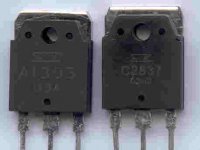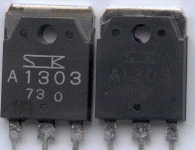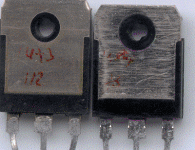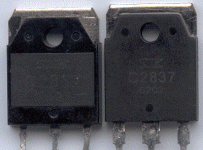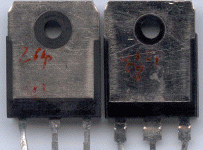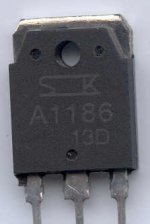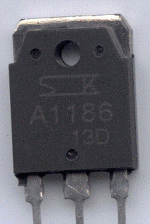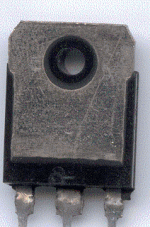The Sanken 2SC2987 seemed to be sold out worldwide for a while. Only Mosspec and WEC "second sources" were available, but these should not really be called second sources because they didn't meet crucial parameters such as cob and fT.
Well, they seem to be back. I have attached a picture of what I just put my hands on. The parts look genuine enough to me. The only puzzling thing is that there is no gain group which all Sanken transistors had that I purchased in the last 3-4 years. Well, maybe they are unselected low cost parts.
I will measure cob and hFE and compare to older parts I still have. Should be able to post my findings tomorrow.
Regards,
Eric
Well, they seem to be back. I have attached a picture of what I just put my hands on. The parts look genuine enough to me. The only puzzling thing is that there is no gain group which all Sanken transistors had that I purchased in the last 3-4 years. Well, maybe they are unselected low cost parts.
I will measure cob and hFE and compare to older parts I still have. Should be able to post my findings tomorrow.
Regards,
Eric
Attachments
A1303 last year / this year. Old part has silver print and typical marking of two digit number (73) and gain group (O). Bottom center mold hole bearks SK mark.
New part is laser engraved or etched. Not clear whether marking O3A specifies gain group.
Back sides, old/new:
Back plate is smooth and flat without sanding marks. New part was sanded before molding.
New part is laser engraved or etched. Not clear whether marking O3A specifies gain group.
Back sides, old/new:
Back plate is smooth and flat without sanding marks. New part was sanded before molding.
2SC2837, old and new.
Old part is laser engraved on rough rectangle. Code is F 0 27. Unclear wheter 0 actually means O, i.e. the gain group. No letters in the mold holes.
New part is laser engraved with smaller print. Writing is weaker , and when one looks more closely, it seems to be double printed with a diagonal offset. Either it really was printed twice, or the optics of the laser were really badly adjusted. Date code 0202 could or could not contain gain group.
Old part is laser engraved on rough rectangle. Code is F 0 27. Unclear wheter 0 actually means O, i.e. the gain group. No letters in the mold holes.
New part is laser engraved with smaller print. Writing is weaker , and when one looks more closely, it seems to be double printed with a diagonal offset. Either it really was printed twice, or the optics of the laser were really badly adjusted. Date code 0202 could or could not contain gain group.
Attachments
capacitance measurements on genuine parts
h_FE as measured with a multimeter was consistent with spec sheets. To really tell genuine parts, one would need to do pulsed measurements at various collector currents up to 5 or 10 A.
A more easily accessible figure is the base collector capacitance. This is usually specified at some collector-emitter voltage of 10 - 80V and some frequency of 1 - 10 MHz.
With a multimeter, you measure without a CE voltage and at a few hundred Hz. However, this number is closely related to the spec values.
For genuine (silver print) Sanken parts (which are specified at 80 V and 1 MHz) and my multimeter, there is a factor of 3.5 - 4. Example
pair spec pF measurement
A1216/C2922 500/250 1620/945
A1303/C3284 400/200 1460/790
Another interesting thing to note is that for Sanken and other brand items, this capacitance varies +/-5% for parts with the same date stamp and maybe +/- 10% for parts from different lots. Unlike h_FE, the capacitance is determined by the geometry of the mask layout, and not by how well the diffusion process went for this wafer.
h_FE as measured with a multimeter was consistent with spec sheets. To really tell genuine parts, one would need to do pulsed measurements at various collector currents up to 5 or 10 A.
A more easily accessible figure is the base collector capacitance. This is usually specified at some collector-emitter voltage of 10 - 80V and some frequency of 1 - 10 MHz.
With a multimeter, you measure without a CE voltage and at a few hundred Hz. However, this number is closely related to the spec values.
For genuine (silver print) Sanken parts (which are specified at 80 V and 1 MHz) and my multimeter, there is a factor of 3.5 - 4. Example
pair spec pF measurement
A1216/C2922 500/250 1620/945
A1303/C3284 400/200 1460/790
Another interesting thing to note is that for Sanken and other brand items, this capacitance varies +/-5% for parts with the same date stamp and maybe +/- 10% for parts from different lots. Unlike h_FE, the capacitance is determined by the geometry of the mask layout, and not by how well the diffusion process went for this wafer.
and now some measurments on the new shipment
Last year's C2837 measured around 250-265 pF, which is a factor of 4.1 to the spec of 60 pF, so this is within the expected range.
The new parts are typically at 400-500 pF, two out of the ten shipped are at 260 and 275 pF, i.e. comparable to the old shipment. Another two have 703 and 786 pF. So on average, the capacitance is twice as high, and there is a really untypically high variation.
Just for comparison, two unreal second source C2837 from WEC measured 406 and 423 pF, i.e. the same as the new SK parts.
=> I would be tempted to assume that the C2837 parts I received are fakes.
The A1303 parts I received in the same shipment all measure 428 to 512 pF. This +/- 10% variation is a little unusual for a lot with the same date stamp, but much much closer than the C2837 parts. The really surprising thing is that this is virtually the spec value at 80 V and only a third of what I measured on parts with silver printing that look 100% genuine to me.
=> Either Sanken has improved the process dramatically (without changing the data sheet) or these are also fakes with a much smaller chip.
Last year's C2837 measured around 250-265 pF, which is a factor of 4.1 to the spec of 60 pF, so this is within the expected range.
The new parts are typically at 400-500 pF, two out of the ten shipped are at 260 and 275 pF, i.e. comparable to the old shipment. Another two have 703 and 786 pF. So on average, the capacitance is twice as high, and there is a really untypically high variation.
Just for comparison, two unreal second source C2837 from WEC measured 406 and 423 pF, i.e. the same as the new SK parts.
=> I would be tempted to assume that the C2837 parts I received are fakes.
The A1303 parts I received in the same shipment all measure 428 to 512 pF. This +/- 10% variation is a little unusual for a lot with the same date stamp, but much much closer than the C2837 parts. The really surprising thing is that this is virtually the spec value at 80 V and only a third of what I measured on parts with silver printing that look 100% genuine to me.
=> Either Sanken has improved the process dramatically (without changing the data sheet) or these are also fakes with a much smaller chip.
A1186 front
After these experiences, I ordered a single A1186 from that supplier. Haven't measured it yet, but again, there is no gain group. The printing looks different again. At first, it looks like lasered, but it is not even and seems to be printed or etched, but not very professionally.
After these experiences, I ordered a single A1186 from that supplier. Haven't measured it yet, but again, there is no gain group. The printing looks different again. At first, it looks like lasered, but it is not even and seems to be printed or etched, but not very professionally.
Attachments
back side
The back side has not been sanded, but I have never seen anything this uneven from Sanken. The sides of the metal tab are slightly rounded, and the top has a residual unevenness from the press, it comes out by about 0.1 mm.
The leads look pretty dull, like they were coated with tin with a very high lead content.
The back side has not been sanded, but I have never seen anything this uneven from Sanken. The sides of the metal tab are slightly rounded, and the top has a residual unevenness from the press, it comes out by about 0.1 mm.
The leads look pretty dull, like they were coated with tin with a very high lead content.
Attachments
Others Sanken outputdevices
Take a look at some other fake Sanken
outputdevices:http://www.ampslab.com/fakes/fakesanken1.htm
Take a look at some other fake Sanken
outputdevices:http://www.ampslab.com/fakes/fakesanken1.htm
The problem in Europe is that there are only a few distributors (Spoerle, Glyn) that carry Japanese semiconductors, and they certainly do not carry the full program.
So all electronics retailers with a large program of Japanese transistors buy from free importers to get the rest not available from the distributors. Some are fair enought to tell you whether it is the original brand or not, with others there is no way of telling until the parcel arrives.
With Sanken, though, this is unnecessary, because Spoerle carries them.
So all electronics retailers with a large program of Japanese transistors buy from free importers to get the rest not available from the distributors. Some are fair enought to tell you whether it is the original brand or not, with others there is no way of telling until the parcel arrives.
With Sanken, though, this is unnecessary, because Spoerle carries them.
Hi!
Problem is, Spoerle does not sell to private customers.
And they are the ones who do the sample distribution for National Semiconductor, and, although National told them to give out samples to private persons, they refuse to do so since February...
So I don't like them very much
In Germany, you could buy Sankens at Reichelt, or at Schuro (with Schuro having the advantage of carrying matched Sanken devices, but also the disadvantage of very bad customer service)...
I am currently playing with the idea of rebuilding my P3A with Sanken 2SC2922 / 2SA1216 as power transistors, and D1763A / B1186A as driver transistors... those are also the devices LCAudio uses for their ZapSolute and End Millenium amps...
Oh, btw, does someone know where to find datasheets for Japanese transistors? I am especially looking for sheets for those D1763A and B1186A devices...???
Bye,
Arndt
Problem is, Spoerle does not sell to private customers.
And they are the ones who do the sample distribution for National Semiconductor, and, although National told them to give out samples to private persons, they refuse to do so since February...
So I don't like them very much
In Germany, you could buy Sankens at Reichelt, or at Schuro (with Schuro having the advantage of carrying matched Sanken devices, but also the disadvantage of very bad customer service)...
I am currently playing with the idea of rebuilding my P3A with Sanken 2SC2922 / 2SA1216 as power transistors, and D1763A / B1186A as driver transistors... those are also the devices LCAudio uses for their ZapSolute and End Millenium amps...
Oh, btw, does someone know where to find datasheets for Japanese transistors? I am especially looking for sheets for those D1763A and B1186A devices...???
Bye,
Arndt
- Status
- This old topic is closed. If you want to reopen this topic, contact a moderator using the "Report Post" button.
- Home
- Amplifiers
- Solid State
- Possibly fake Sanken output trannies (PIC)
